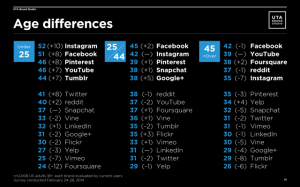You probably know at this point in your social media career that you cannot possibly help your clients by just placing them on every social network known to man. More does not necessarily mean better.
Besides, who has time to be on Facebook, Twitter, LinkedIn, Pinterest, Google+, Instagram, Vine, Periscope, Reddit, StumbleUpon, Blab, and countless other social networks. Certainly neither your clients and nor you even if you want to successfully sell them on your services.
Therefore, knowing you cannot join every network is the first step in helping your clients with a targeted social media marketing strategy. Now, you need to determine the best social media marketing platforms for your clients.
To accomplish these goals, we want to take you through some simple steps to determine the best social networks for your clients.
5 Steps to Determine the Best Social Media Marketing Platform
- Make mistakes– As Buffer founder, Kevan Lee stated, “When I started at Buffer, I was given permission to make mistakes, to ask forgiveness rather than permission, to always test everything. So I’d like to give you all some permission as well.”
Yes, you should not spend your time divided between all of the social networks when you start. However, that does not mean you should not play around with different networks to see which ones provide the most bang for your buck.
At the end of the day, you will make mistakes either way. It is impossible to know exactly what every client needs from the get go.
Therefore, accept this ahead of time, and play around with the different networks to determine how they can help your clients achieve their goals.
- Ask the right questions. Part of determining the social media marketing platforms for your clients involves asking the right questions.
The vertical response has a number of useful questions to help their clients find the right social media channel.
They ask the following questions:
- What is the unique purpose of this platform?
- Do its attributes relate to my business’s needs?
- Which target audience does this platform serve?
- How much time on this network is necessary to have the best impact?
They are able to improve the quality of service they provide to their clients by asking their clients these questions that is because they need to know each client’s unique purpose for using specific social networks.
Understand how you can position your customers success on their respective networks. For example, Facebook is an ideal social network to share information about a business and acquire testimonials and personal stories from clients that you can easily share with your fan page and social network.
By assessing the needs of your client, you then determine how to effectively achieve your goals in the least amount of time.
- Evaluate demographics- Facebook is an ideal platform if you want to generate testimonials, share personal stories, and depict your business to prospects. However, if you decide instead that you want to drive traffic to your website you might choose Pinterest or Twitter.
While all of the social networks can perform both of these functions, the short post format works especially well in generating traffic.
For example, numerous mommy bloggers use Pinterest to share images of their kids that link back to their blogs. The image captures the user’s attention, and the link allows the user to directly connect to the blog.
Also, use data like age differences to determine which social network you can use for your prospects.
As you can see from the chart below from UTA Brand Studio, if you want to connect with Millennials use social networks like Instagram, Facebook, and Tumblr. Conversely, if you want to speak with Baby Boomers use Facebook, YouTube, and Reddit.
While Facebook is large enough to have captured most of the market across demographics, the other networks come represent specific target markets.
Demographics is one of the most important factors in the success of any social media campaign. It is why for years, many small businesses failed to succeed online even when they generated huge amounts of traffic. Here comes the social media company. These companies’ runs social media campaigns on the basis of demographic analysis on behalf of those SMEs.
When you understand where your target audience spends their time and money, you can begin to leverage that knowledge to grow your own business.

- Test new and different mediums– It is okay to find a niche social network for you to utilize. However, you need to continually experiment to see how other social networks work.
For example, last year Purina ONE Cat created their first video on Twitter-owned Periscope. The series of videos entitled One Cat Compare over 16 hours of shots broken down into short videos on pet wellness, pet care, and physical activities.
Part of this was also done live at a pop-up shop where visitors were encouraged to adopt a pet. The Periscope videos generated another 10,000 live views and 60,000 likes across all of the live and the recordings of the videos over the next 24 hours.
The key here is that by testing out new ground on different social networks, Purina One was able to stand out from the crowd. That might be the greatest strength for any business looking to tweak their marketing plan in 2016.
- Determine your budget– The final item that we want to bring up is that once you have your target market in mind, think about the budget you have in mind for your campaign.
Some networks you might still be able to get away with doing all free work. However, others you will either have to pay for ads or other services.
A prime example is LinkedIn. Over the past year, they have increased the price of their paid plans and also restricted the features of the free plans. Therefore, be prepared if you are active on the social network to spend between $50-$150 per month on paid services.
Furthermore, ad budgets can build up quickly. At a minimum, new businesses should spend $30 every month on ads. However, you should encourage your clients to spend a minimum of $500-$1000 or more on social ads.
If your clients fight you on this, remind them that this is cheap in comparison to some of the budgets needed to succeed with search and television ads these days.
Final Thoughts
Do you have a better idea of what social networks work best for your clients? Or are you still ideas up in the air as you struggle to determine the right marketing mix?
Use the steps above as a guideline to figure out the best social media services for your business. Then in the comments, let us know what you found to be the most useful step to determining the best social media marketing platform for your clients.




